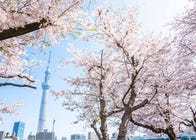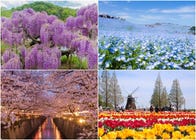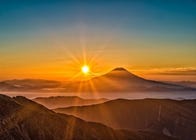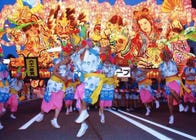
Seasons of Japan: Learn All About Climate and Weather in Japan Before Traveling
- Written by: Steve Csorgo
Japan's weather brings it all. The majestic cherry blossoms of spring. The warmth of summer. The breathtaking autumn leaves. The crisp white winter landscapes. Each of the four seasons of Japan brings a new face to the country, each as beautiful as the next.
Deciding which side of Japan you want to see is vital to planning the perfect trip! To help you plan, we've created the ultimate guide to the seasons of Japan and its climate. Use this guide to get an idea of what to expect in Japan throughout the year, so you can plan the trip you've been dreaming of!
What's Japan Like in Spring?
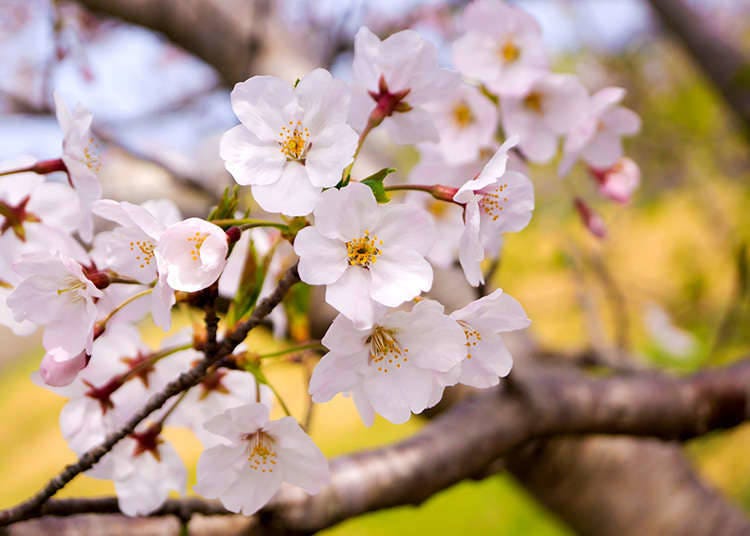
Spring brings glorious weather to much of Japan, with cool, sunny days becoming more frequent as this favorite of the seasons of Japan progresses. This makes it one of the best times to visit Japan!
However, chilly nights and rain are still abundant, so be sure to check the forecast before heading out. Northern areas, such as Hokkaido and Tohoku, are prone to cold weather until May, and mountainous regions will still be covered in snow across Japan.
When is spring in Japan?
Spring in Japan is from March to May.
- Kanto (Tokyo, Yokohama, Saitama, etc.)
- From late March the temperature will be comfortable enough to be outdoors. However, while beautiful sunny days are plentiful, so are rainy ones, so don't forget your wet-weather gear. April will see average highs of 19℃ (66℉).
- Kansai (Osaka, Kyoto, Nara, Mie, etc.)
- Daytime temperatures often exceed 20℃ (68℉), making Kansai a very pleasant place to be. However, windy and rainy days are prevalent in March and April. May becomes noticeably calmer and is adored by locals.
- Tohoku / Shinetsu / Hokuriku
- Winter conditions continue for all of March and most of April. May will finally bring forth nice weather, although it may still be too cold to sit outside. Aomori will experience an average high of 14℃ (57℉) in April.
- Hokkaido
- Snow and ice will no longer be a problem in most low-lying towns from mid-April as warmer days slowly emerge. Mountains will still be snowy, and snowfall can occur as late as April. Sapporo’s average high is 11℃ (53℉) for April.
- Kyushu
- Days in Kyushu are mild and sunny, with Fukuoka enjoying an average of 15℃ (60℉) during April, with many days reaching over 20℃ (68℉).
Things to do in Japan in Spring
After a cold winter, the much-welcomed warming of Japan means it's time to get back outdoors! Hiking through forests, traversing cities, and chilling out in parks are just some of the ways you can savor this fantastic of seasons of Japan. The biggest highlight in spring is the world-famous cherry blossoms, which bloom in Tokyo from late-March to early-April.
However, if you're visiting a famous cherry blossom spot, such as Ueno Park or Shinjuku Gyoen, be prepared for crowds, especially on weekends. Dozens of other stunning spring flowers, including roses, tulips, wisteria, and rapeseed, many of which have their own dedicated parks and festivals, can also be found!
Packing for Spring in Japan
As spring's weather can be unpredictable, packing for both warm and cold conditions is advised. If you're heading to Japan's north in early spring, snow gear, such as puffer jackets, snow boots, scarves, and beanies are a must.
Related Articles
We have area-specific Spring guides for: Hokkaido, Osaka, Kyoto, Kobe and Tohoku.
When is Rainy Season in Japan?

From the end of May to mid-July is the "rainy season" called "Tsuyu." Even when it is not raining, the humidity gets high as the temperature rises. The rainy season of Japan starts early in the southern part of Japan and gradually shifts northward, which takes about a month. However, Hokkaido does not experience Tsuyu. When the rainy season ends, the real hot summer begins.
What's Japan Like in Summer?
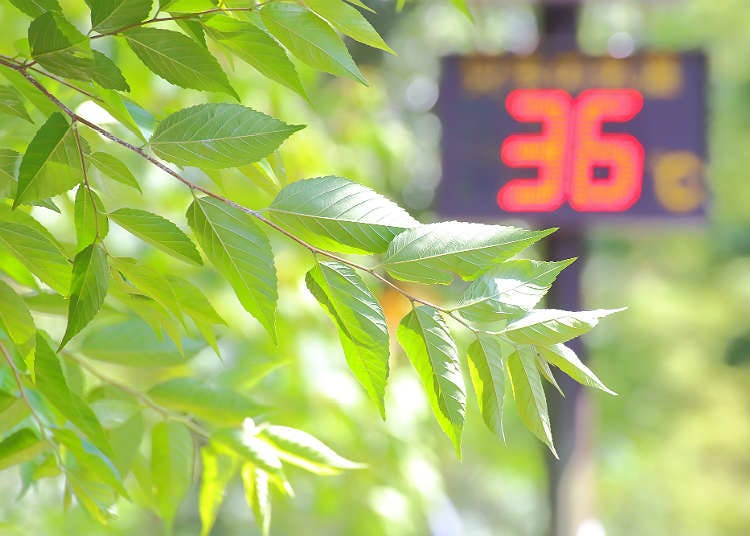
Humid, humid, humid! From June to late July, thick humidity will dominate due to the meeting of cold air from the north and warm air from the south. This phenomenon will make you sweat quickly and long for an air-conditioned room.
While referred to as the 'rainy season' in English, central metropolises like Tokyo and Osaka don't have much more rainfall than spring. However, the rain during this period can be sudden and heavy or can consist of light showers that span the entire day. Be prepared to get wet at some point.
Heading up to Hokkaido is a great way to escape this weather, as the island is too far north to experience a proper rainy season. Once July passes, the temperature soars with days as high as 35℃ (95℉), and clear blue skies become commonplace.
Be on the lookout for typhoons. While they may occur at any time during summer or autumn, they are most common in August and September, and may disrupt your travel plans and pose a danger.
When is summer in Japan?
Summer in Japan is from June to August.
Related Articles
We have area-specific Summer guides for: Hokkaido, Osaka, Kyoto, Kobe and Tohoku.
- Kanto (Tokyo, Yokohama, Saitama, etc.)
- Summer can be very brutal in Kanto, especially in built-up areas. Rain will peak in June, but will drop to the same levels as spring from July. Average daily highs in July will be 29℃ (85℉), but due to the humidity it will feel a lot hotter.
- Kansai (Osaka, Kyoto, Nara, Mie, etc.)
- Kansai also experiences a vigorous rainy season, with numerous humid and hot days every month. Many days will exceed 30℃ (86℉) during July in Osaka and Kyoto.
- Tohoku / Shinetsu / Hokuriku
- While a little later than the rest of the mainland, the rainy season won't spare these northern lands. However, the weather will remain a little cooler than Kanto, with Sendai experiencing an agreeable mean temperature of 20℃ (69℉) during July.
- Hokkaido
- Hokkaido will avoid most of the rainy season, and instead enjoy well-deserved sunny and consistent weather. Evenings and nights can still be chilly. The average temperature in July for Sapporo is 20℃ (69℉).
Things to do in Japan in Summer
Summer means festival season in Japan! While not so common in June, late July and August are brimming with traditional and modern festivals all across the country.
Some prominent summer festivals include Shinjuku Eisa Festival in Tokyo, the Gion Festival in Kyoto, and the Tenjin Festival in Osaka. Often coinciding with festivals, breathtaking fireworks shows can also be found almost every night somewhere across Japan, making for a magical way to spend an evening.
If you're looking to beat the heat, there's nothing more energizing than taking a dip at one of Japan's hundreds of stunning beaches, many of which can be reached from major cities. Some refreshing day-trip beaches from Tokyo can be found here!.
Trivia: Seasonal words for summer
Your days will be accompanied by exasperated sighs of 'atsui,' meaning 'hot.' Japanese people, many of whom wear suits despite the unbearable swelter, love to chat about the summer heat, and 'atsui' will be used almost as if it were a greeting. 'Matsuri' is a traditional Japanese festival, and 'hanabi,' literally meaning 'fire flowers,' is the Japanese name for fireworks. The Japanese word for summer is 'natsu.'
Packing for Summer in Japan
Wearing light, breezy clothes will help you feel fresh amid this challenging weather. If you're planning on hiking or heading north, also pack a set of warmer clothes. Sunglasses and a hat are another must! Buy yourself some sunscreen and a cheap umbrella at a convenience store once you arrive.
When is Typhoon Season in Japan?
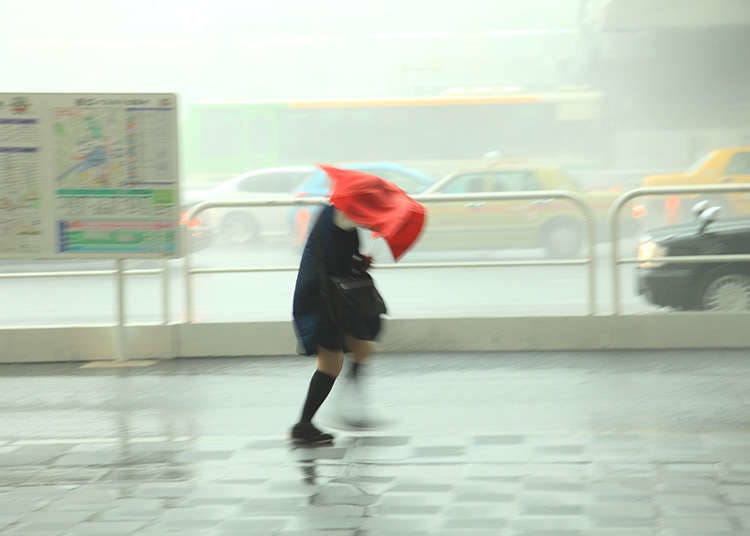
Typhoon season in Japan is toward August and September. Areas in the path of the typhoon will experience strong rain and high winds, which might paralyze public transportation.
What's Japan Like in Autumn?
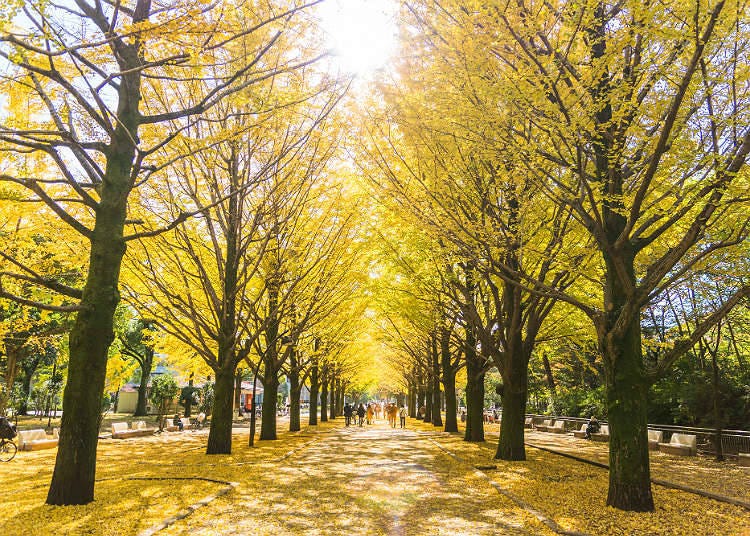
Autumn is a well-received break from the crushing late summer heat, with temperatures gradually dropping each week and the air becoming fresher and drier. Tokyo's climate is particularly pleasant during October and November, with comfortable days and brisk nights providing a delightful atmosphere to enjoy the metropolis. Okinawa is also very agreeable, with daytime temperatures staying well above 20℃ (68℉). However, early autumn is home to the typhoon season, which often wreaks havoc on Japan, particularly affecting southern areas like Okinawa and Kyushu. Keep an eye on the news for warnings.
Just as the cherry blossoms attract crowds in the spring, many tourists gather in Nara prefecture, Kyoto prefecture, and Nikko city to enjoy the beautiful tints of autumn.
In Tokyo, November is the time when the leaves of deciduous trees turn to red and yellow, painting the mountains and streets beautiful colors. Autumn is also a time when many cultural events are happening.
When is autumn in Japan?
Autumn in Japan is from September to November.
- Kanto (Tokyo, Yokohama, Saitama, etc.)
- Despite the change of season, the heat of summer will stick around for September, and even October will feel fairly warm, even at night. By November the air will become dry and cold, making the outdoors very refreshing. Daytime temperatures in Tokyo will hover around 18℃ (65℉) during October. Fall leaves will begin to peak across Kanto from late November. September and October also see high rainfall, before becoming scarce in November.
- Kansai (Osaka, Kyoto, Nara, Mie, etc.)
- Kansai's autumn weather is similar to Kanto, albeit a little warmer in September. Afternoons in Osaka will be around 19℃ (67℉) during October. Fall leaves will peak in some areas in late November, but will mostly be at their best from early December.
- Tohoku / Shinetsu / Hokuriku
- While hot days are plentiful in September, these northern and western prefectures will grow noticeably cold from October. By November chilly nights dipping below 5℃ (41℉) draw a halt to most outdoor activities. Jackets and scarves will soon be required. Aomori will experience snowfall starting from November, with an average of 9 snowy days in the month.
- Hokkaido
- Hokkaido will become cold very quickly, with the fall season starting around mid-September – the earliest in Japan. Winter conditions will arrive from November, meaning thick clothes are a must! Sapporo will see average lows of just 7℃ (45℉) during this time. Precipitation is at its highest during September, so don't forget that raincoat too! Strong winds are common near mountains and on the coastline.
- Kyushu
- Hot, summery weather continues in September before cooling down from mid-October. The frequency of rainy days will also decrease. The abundance of stunning fall leaves throughout the region and agreeable temperatures make it a great time to visit!
Things to do in Japan in Autumn
Autumn is the season to turn-off the air-conditioner and get back outdoors. The low-humidity and crisp air make it perfect for long days of sightseeing. Once the leaves start to change color, explore the parks and mountains to take in the vibrant array of red, yellow, and brown that takes over the mainland. Fortunately, this phenomenon lasts across Japan from October to December so that it can be enjoyed on your schedule!
Trivia: Seasonal words for autumn
Autumn in Japanese is ‘aki.’ ‘Momiji’ refers to the changing leaves of the maple tree, which are said to be the most brilliant fall leaves found in Japan. However, they are not the only beautiful ones, and the word ‘kōyō,’ covers all the other leaves that complete the fiery display.
Packing for Autumn in Japan
Similar to spring, autumn requires a mix of both warm and light clothing. Shorts and T-shirts can be worn in early autumn if you're spending time in cities like Tokyo or Osaka, although chilly nights may require a jacket and long pants. If you're heading to Tohoku or Hokkaido during the latter half of the season, pack warmer than light clothing, and be prepared for snow in November.
Related Articles
We have area-specific Autumn guides for: Hokkaido, Osaka, Kyoto, Kobe and Tohoku.
What's Japan Like in Winter?
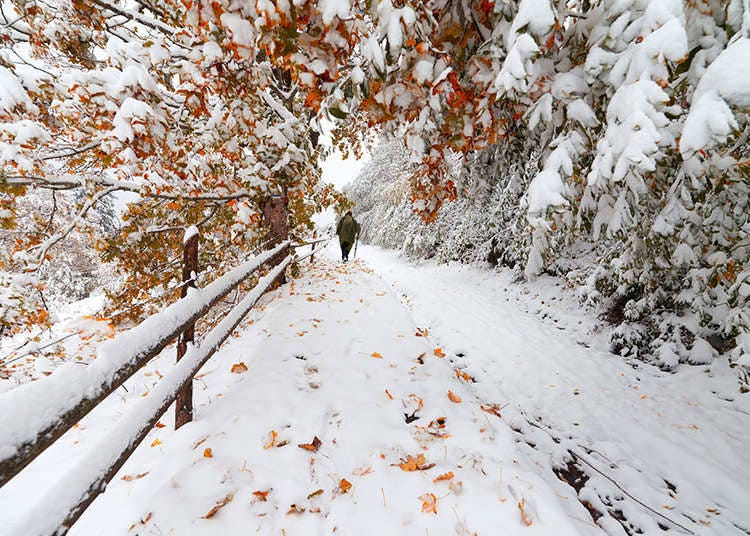
Your experience of winter in Japan will depend on the region. Popular cities, such as Tokyo, Osaka, Hiroshima, and Kyoto, have relatively mild weather, with snow rare and rainfall minimal. While temperatures can get very low, these sunny, dry, and calm days are the perfect opportunity to take in these metropolises without large crowds.
Harsher winter conditions are found in western and northern Japan, which are mostly frozen over and filled with days of storms, blizzards, rain, and heavy snowfall. Prefectures such as Niigata, Nagano, Yamagata, Akita, Fukushima, and Aomori are blanketed in meters of pure white snow, which transforms the landscape into a spectacular winter wonderland.
While Hokkaido doesn’t receive as much snow as mainland Japan, it is still covered with snow and ice for the entirety of winter and is constantly freezing. For those who hate the cold, Okinawa offers a comfortable escape with moderate temperatures and low rainfall, albeit being a little brisk at night.
When is winter in Japan?
Winter in Japan is from December to February.
- Kanto (Tokyo, Yokohama, Saitama, etc.)
- Winter in Kanto is cold, but rarely freezing. Dry, calm, and sunny days are routine, and rainfall and snow rare. Humidity is extremely low, making the air brisk and clear – the views of Mt. Fuji are fantastic. The mean temperature in Tokyo is 6℃ (43℉) in January.
- Kansai (Osaka, Kyoto, Nara, Mie, etc.)
- Kansai’s winter is similar to Kanto, with a slightly higher level of humidity but with less rainfall.
- Tohoku / Shinetsu / Hokuriku
- These northern and western regions are extremely bitter and snowy, with some areas seeing meters-worth of snow in a month. Temperatures will regularly drop below freezing at night. Days are often cloudy, wet, and windy. Sendai and Aomori both have a mean temperature of 1℃ (35℉) during January.
- Hokkaido
- With averages temperatures below freezing, Hokkaido truly earns its reputation as the coldest place in Japan. Icy roads and snow make travel difficult, although the winter scenery is majestic. Sapporo during January will see average lows of -6.9℃ (19.6℉) and highs of just -0.6℃ (31℉).
- Kyushu
- Fukuoka and Kumamoto will have comfortable average highs of 10℃ (50℉) during January. These mild winters make travel easy. The humidity and rainfall levels in the region tend to be higher than central Japan.
- Okinawa
- When compared with the rest of the country, Okinawa barely has a winter. Mild conditions make exploring the islands a breeze, although is it not quite warm enough for sunbathing. The islands are subject to higher rainfall and humidity than the rest of Japan. Mean temperatures are 17℃ (63℉) during February
Things to do in Japan in Winter
Despite the cold, Japan doesn't slow down during winter – quite the opposite! Winter is full of festivals, fireworks, exhibitions, and fun! Most famous are the hundreds of lights displays, known as illuminations, that cover Japan. The snow festivals of February, including the Sapporo Snow Festival and the Hirosaki Castle Snow Lantern Festival, are other must-see winter wonders!
Of course, if you're a skier, then Japan's slopes and powder snow, lovingly referred to by fans as Japow, is first-class. The excellent conditions in Hokkaido are well worth the hefty travel, while Nagano and Niigata provide amazing ski resorts easily assessed from Tokyo by bullet train.
Trivia: Seasonal words for winter
Snow in Japanese is 'yuki.' Similar to 'atsui' in summer, you will often hear locals muttering 'samui,' which means, you guessed it, cold! Winter in Japanese is 'fuyu.'
Packing for Winter in Japan
If you're spending your time in cities like Tokyo, Osaka, Kyoto, Hiroshima, and Nagasaki, a basic winter array of sweaters, pants, jackets, and scarves will suffice. If you're planning on visiting frigid areas, such as Gifu, Nagano, Yamagata, Akita, Fukushima, Aomori, and Hokkaido, investing in some high-quality snow gear is a must.
This includes puffer jackets, snow boots, beanies, thermal underwear, waterproof pants, and more. Many of the cities and towns here will be blanketed with snow and ice and are swept by bone-chilling winds, making traversing them in the same clothes you were wearing in Tokyo potentially dangerous.
Related Articles
We have area-specific Winter guides for: Hokkaido, Osaka, Kyoto, Kobe and Tohoku.
What's the weather like in Japan? Annual average temperature and precipitation
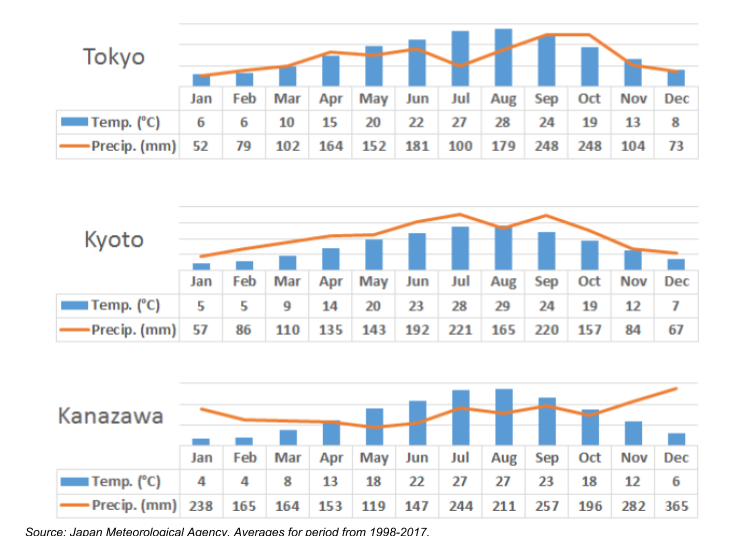
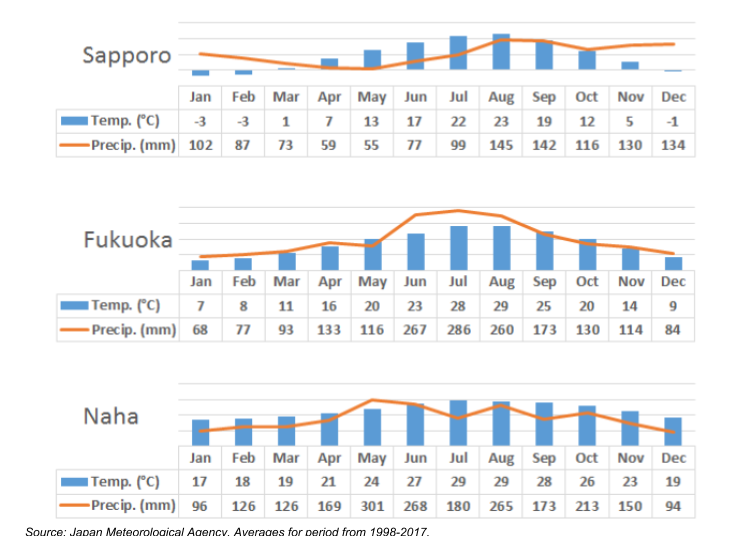
From Melbourne, Australia, Steve lives in Niigata City, two hours north-west of Tokyo. His passions include discovering local sake, dining at interesting restaurants and travelling as much of Japan as possible.
- Category
*Prices and options mentioned are subject to change.
*Unless stated otherwise, all prices include tax.
Popular Tours & Activitiess
Recommended places for you
-
Appealing

Rukku and Uohei
Izakaya
Sapporo / Chitose
-

ISHIDAYA Hanare
Yakiniku
Kobe, Sannomiya, Kitano
-

Kambei Sannomiyahonten
Yakiniku
Kobe, Sannomiya, Kitano
-

Kanzenkoshitsuyakinikutabehodai Gyugyu Paradise Sannomiya
Yakiniku
Kobe, Sannomiya, Kitano
-

Jukuseiniku-to Namamottsuarera Nikubaru Italian Nikutaria Sannomiya
Izakaya
Kobe, Sannomiya, Kitano
-
Goods

Yoshida Gennojo-Roho Kyoto Buddhist Altars
Gift Shops
Nijo Castle, Kyoto Imperial Palace
-
Ad

Discover the "Miraculous Forest" in the Heart of Tokyo: The Institute for Nature Study (9 Minutes from JR Meguro Station)
-

First Japan Cherry Blossom 2026 Forecast Announced! Here's When & Where to See Sakura in Japan
-
Ad

(Opening in Jan 2026) 'THE SUMO LIVE RESTAURANT HIRAKUZA GINZA TOKYO!' 5 Exciting Ways to Experience the World of Sumo!
-

Strawberries, Style, and Tokyo’s Coolest Neighborhood: Winter Afternoon Tea in Kichijoji
by: Guest Contributor
-
Ad

Complete Guide to Ueno's National Museum of Nature and Science, the Perfect Place to Visit on Rainy Days or With Children
-

Japan’s Shinkansen Is About to Change Travel in an Unexpected Way
by: Guest Contributor
-

Complete Guide to Niigata Airport (KIJ): Dining, Souvenirs, Massages, and More!
-

Hasshoku Center: Enjoy Famous Seafood Bowls at Aomori's Giant Fish Market
-

5-Day Hokkaido Road Trip Itinerary for Spectacular Sights in Spring/Summer
-

Admire Tokyo’s Prettiest Cherry Blossoms at Chidorigafuchi Moat
-

Sakura In Hokkaido - Top 10 Sakura Spots Recommended by a Long-Time Resident of Sapporo
-

Top 10 Places in Iwate to See the Cherry Blossoms in 2026
by: Alexander Litz
- #best sushi japan
- #what to do in odaiba
- #what to bring to japan
- #new years in tokyo
- #best ramen japan
- #what to buy in ameyoko
- #japanese nail trends
- #things to do japan
- #onsen tattoo friendly tokyo
- #daiso
- #best coffee japan
- #best japanese soft drinks
- #best yakiniku japan
- #japanese fashion culture
- #japanese convenience store snacks














